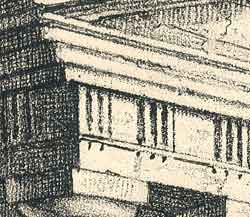TYPES OF PRINTS: LITHOGRAPHY

The lithography process is again quite different to the methods described so far. It belongs to the class of prints known as planographic or surface prints. This is the basis if all modern printing, like the ‘offset litho’ process used for magazines and colour printing.
Lithography relies on a simple fact – oil and water do not mix! A drawing is made directly onto the surface of the lithographic stone with a greasy pen or pencil. The stone is dampened. ‘Greasy’ ink is passed over the stone surface, and the ink adheres to the greasy parts but not the damp areas. Then, a sheet of paper is lightly pressed onto the sto ne. This picks up the ink, leaving the un-drawn areas as plain paper. ne. This picks up the ink, leaving the un-drawn areas as plain paper.
As the pressure applied is quite low, there is no platemark left with the process, as with the intaglio methods. The sample shows the characteristic ‘grainy’ surface of the lithograph.
The process was invented around 1798/99 in Germany, but it took until the 1820s before the benefits of the technique were fully realised. After that, the process very rapidly replaced most other methods of printing. In England, the greatest exponent of lithography was the printer, Hullmandel, whose name is often found on prints from the 1820s to 1850s. In our prints for sale section, we usually try to have some examples of his work.
Michael Tywman’s classic book, Lithography 1800-1850, OUP 1970, explains the whole process.
email ross@georgianprints.co.uk
|